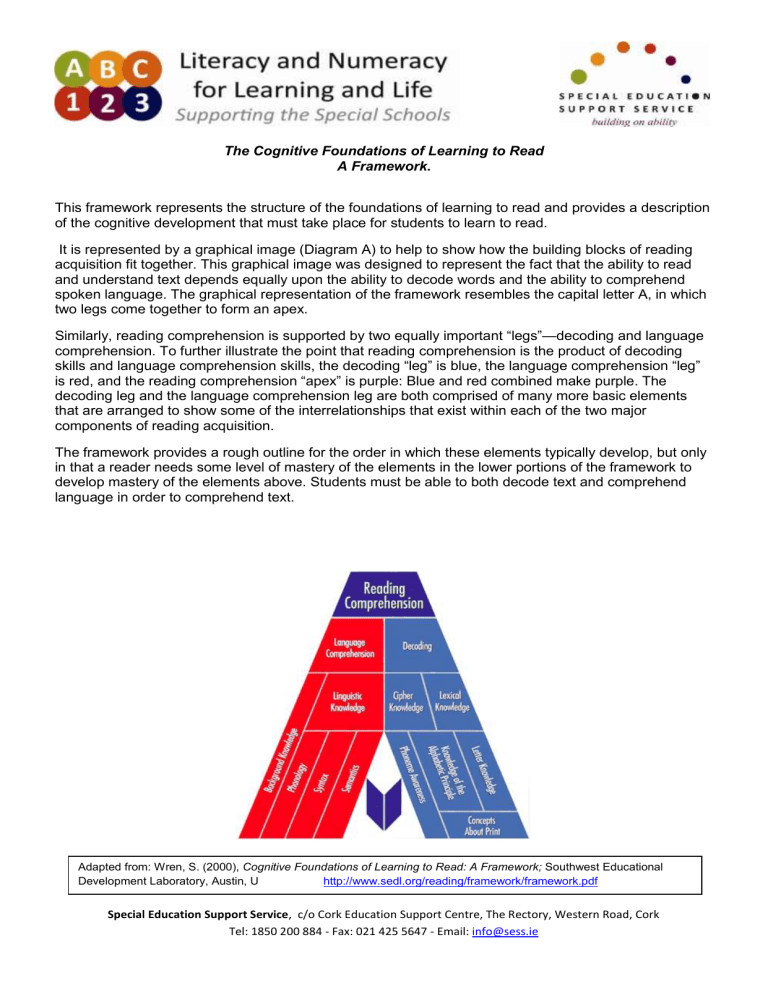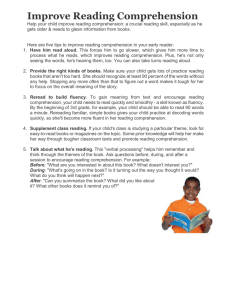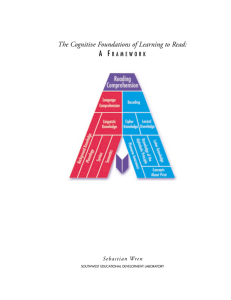The Cognitive Foundations of Learning to Read: A Framework

The Cognitive Foundations of Learning to Read
A Framework.
This framework represents the structure of the foundations of learning to read and provides a description of the cognitive development that must take place for students to learn to read.
It is represented by a graphical image (Diagram A) to help to show how the building blocks of reading acquisition fit together. This graphical image was designed to represent the fact that the ability to read and understand text depends equally upon the ability to decode words and the ability to comprehend spoken language. The graphical representation of the framework resembles the capital letter A, in which two legs come together to form an apex.
Similarly, reading comprehension is supported by two equally importa nt “legs”—decoding and language comprehension. To further illustrate the point that reading comprehension is the product of decoding skills and language comprehension skills, the decoding “leg” is blue, the language comprehension “leg” is red, and the read ing comprehension “apex” is purple: Blue and red combined make purple. The decoding leg and the language comprehension leg are both comprised of many more basic elements that are arranged to show some of the interrelationships that exist within each of the two major components of reading acquisition.
The framework provides a rough outline for the order in which these elements typically develop, but only in that a reader needs some level of mastery of the elements in the lower portions of the framework to develop mastery of the elements above. Students must be able to both decode text and comprehend language in order to comprehend text.
Adapted from: Wren, S. (2000), Cognitive Foundations of Learning to Read: A Framework; Southwest Educational
Development Laboratory, Austin, U http://www.sedl.org/reading/framework/framework.pdf
Special Education Support Service, c/o Cork Education Support Centre, The Rectory, Western Road, Cork
Tel: 1850 200 884 - Fax: 021 425 5647 - Email: info@sess.ie
Glossary of Framework Elements
Alphabetic Principle – Spoken words are made up of phonemes, and written words are made up of letters. However, knowledge of those two facts is not sufficient for developing good decoding skills.
Knowledge of the alphabetic principle refers to an understanding that the letters in written words represent the phonemes in spoken words.
Background Knowledge – In order to understand language, the student must have some background knowledge to use as a reference for interpreting new information. Moreover, if the student is expected to understand something specific, her background knowledge must be relevant to what she is expected to understand.
Cipher Knowledge – The relationship between the way a word is spelled and the way that word is pronounced in English is reasonably predictable. Certain conventions, collectively known as the English cipher, loosely govern English spelling and pronunciation. To be able to decode words, students need an implicit understanding of those conventions.
Concepts About Print
– Understanding print involves recognising and understanding the mechanics of text. A reader must understand that text contains a message; that it flows from left to right and from top to bottom; that individual words on the page correspond to individual spoken words, and so on. Written
English has a structure, and understanding that structure is prerequisite to good decoding skills.
Decoding
– Good readers are able to correctly pronounce familiar words (at the reader’s level) whether they be regular or irregular words, and are able to pronounce unfamiliar words in a way consistent with the conventions of written English. For skilled readers, decoding is so automatic that it requires virtually no conscious effort, so the reader can devote full attention to the task of comprehending the text.
Language Comprehension – To read and understand text, a student needs to be able to understand language. Before expecting a student to be able to read and understand a story, the question should be asked, “Could the student understand this story if it was read to her?” An essential aspect of language comprehension hinges on the ability to draw inferences and appreciate implications —it is important to understand both the explicit and implicit messages contained in language.
Letter Knowledge – The letter is the basic unit of reading and writing in English, and familiarity with the letters of the alphabet has consistently been shown to be a strong predictor of future reading success.
While not sufficient in itself for reading success, familiarity with the letters of the alphabet is important for developing decoding skills.
Special Education Support Service, c/o Cork Education Support Centre, The Rectory, Western Road, Cork
Tel: 1850 200 884 - Fax: 021 425 5647 - Email: info@sess.ie
Lexical Knowledge – Some words cannot be easily sounded out because they do not follow the conventional letter-phoneme relationships —a student who attempts to sound out words like “one” and
“two” will not arrive at the correct pronunciation. For these “exception” words, the student will need additional information about correct pronunciation.
Linguistic Knowledge – Most of the problem of understanding language hinges on the knowledge of the mechanics of that language. All languages have structure, and an implicit knowledge of that structure is essential to comprehension.
Phoneme Awareness – One of the most basic building blocks of speech is the phoneme, and to gain knowledge of the alphabetic principle, a student must be consciously aware that spoken words are comprised of phonemes. Further, that student must be consciously aware of the fact that phonemes can be substituted and rearranged to create different words.
Phonology – Speech is the most typical form of language, and in order to understand speech, a student must be able to clearly hear, distinguish, and categorise the phonemes within the speech. A student who is unable to distinguish between similar phonemes may develop difficulties with comprehension. A student who has difficulty with English phonology may not be able to hear the difference between words like “thin” and “fin” or “here” and “hair,” and those words may confuse the student when they come up in context.
Reading Comprehension – Reading comprehension is composed of two equally important components. Decoding, or the ability to translate text into speech, is only part of the process of reading comprehension. The other part is language comprehension, or the ability to understand spoken language. All struggling readers have difficulty with either language comprehension or decoding or both.
Semantics – To understand language, a student must understand the meaning of word parts
(morphology) and individual words within the language (vocabulary), but more than that, a student must understand that words are arranged in sentences and discourse in meaningful ways. The student must understand how to use language to communicate complete and meaningful ideas.
Syntax – Understanding isolated words is not adequate for the task of understanding language. All languages have rules regarding how words can be combined to form sentences, and an implicit understanding of the rules of sentence structure and phrasing is essential to comprehension.
Adapted from: Wren, S. (2000), Cognitive Foundations of Learning to Read: A Framework; Southwest Educational
Development Laboratory, Austin, U http://www.sedl.org/reading/framework/framework.pdf
Special Education Support Service, c/o Cork Education Support Centre, The Rectory, Western Road, Cork
Tel: 1850 200 884 - Fax: 021 425 5647 - Email: info@sess.ie







